Llanelli railway station

Llanelli railway station is the railway station serving the town of Llanelli, Carmarthenshire, Wales. It is located on the West Wales line and the Heart of Wales line 225 miles 20 chains (362.5 km) from the zero point at London Paddington, measured via Stroud. The station and the majority of trains calling are operated by Transport for Wales. It is located between two level crossings (known as East and West) that were previously upgraded in the 1970s. In 2015, Network Rail carried out a further upgrade which saw the control of these level crossings pass from the Grade-II listed Llanelli West signal box (which worked the two crossings here only since 1973) to Port Talbot Panel Signal Box using CCTV.
Excerpt from the Wikipedia article Llanelli railway station (License: CC BY-SA 3.0, Authors, Images).Llanelli railway station
Great Western Crescent,
Geographical coordinates (GPS) Address Website Nearby Places Show on map
Geographical coordinates (GPS)
| Latitude | Longitude |
|---|---|
| N 51.674 ° | E -4.161 ° |
Address
Great Western Crescent
SA15 2RN , Tyisha
Wales, United Kingdom
Open on Google Maps







